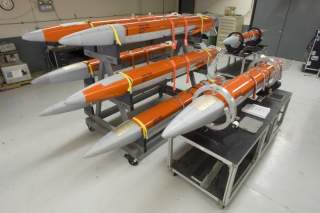U.S. Military Successfully Tested Its Latest Super Weapon: ‘The Swarm’
Future swarming drones could be used to for everything from taking down enemy air defenses to electronic warfare to reconnaissance.
The United States Navy and the Pentagon’s secretive Strategic Capabilities Office have demonstrated swarming autonomous drone technology in flight using over 100 unmanned aircraft. During the test—which was conducted over China Lake, California—three Boeing F/A-18E/F Super Hornets launched 103 Perdix drones that demonstrated swarm behaviors such as collective decision-making, adaptive formation flying and self-healing.
“Due to the complex nature of combat, Perdix are not pre-programmed synchronized individuals, they are a collective organism, sharing one distributed brain for decision-making and adapting to each other like swarms in nature,” SCO Director William Roper said in a statement. “Because every Perdix communicates and collaborates with every other Perdix, the swarm has no leader and can gracefully adapt to drones entering or exiting the team.”
This particular demonstration is one of the first examples where the potential of autonomous swarms is truly on display. Previously, the Defense Department would have to use to large unmanned aircraft—which cost as much as a manned aircraft—to achieve the same effect. With the use of this technology, the enemy has to work much harder to take down individual components of the swarm to destroy it. Moreover, the swarm is still operational even after multiple aircraft have been destroyed—allowing for a graceful degradation of the collective whole as it comes under attack. Thus, once the swarm technology is operational—the potential is almost limitless.
The Pentagon is working on transitioning the Perdix—one of the fruits of the Defense Secretary Ash Carter’s Defense Industrial Unit-Experimental (DIUx) effort—into an operational aircraft. One of the challenges will be to find to a company that will be able develop the Massachusetts Institute of Technology (MIT) Lincoln Laboratory design into a mass production model. The Defense Department wants to be able to build the Perdix in batches of up to 1,000.
According to the Defense Department, engineering students at MIT developed the Perdix in 2013, but the technology was adapted for military use. Unlike a typical military design, Perdix is based on commercial technology—like a smartphone—has been continually upgraded since its inception.
“Now in its sixth generation, October's test confirmed the reliability of the current all-commercial-component design under potential deployment conditions—speeds of Mach 0.6, temperatures of minus 10 degrees Celsius, and large shocks—encountered during ejection from fighter flare dispensers,” reads a Pentagon release.
The Perdix is just the harbinger of things to come. Future swarming drones could be used to for everything from taking down enemy air defenses to electronic warfare to reconnaissance. The technology is in its infancy, but the potential is just being unlocked for the first time.
Dave Majumdar is the defense editor for The National Interest. You can follow him on Twitter: @davemajumdar.
Image: Raytheon.

